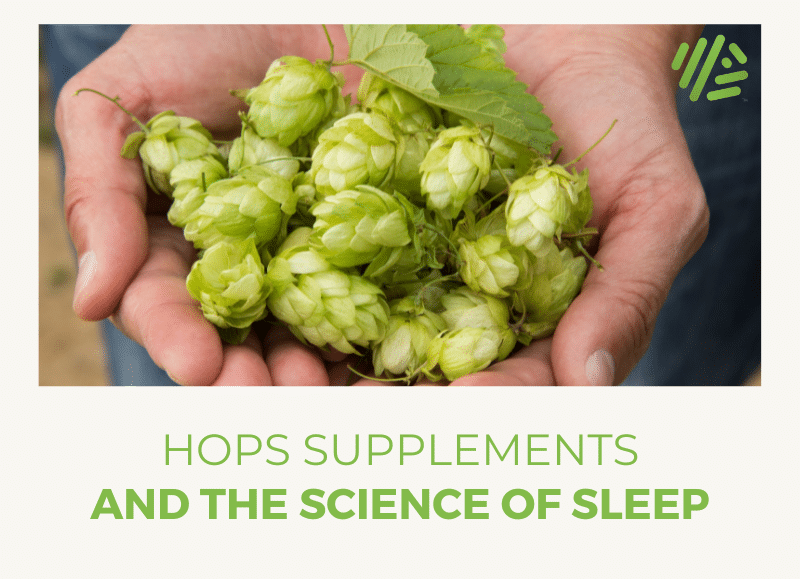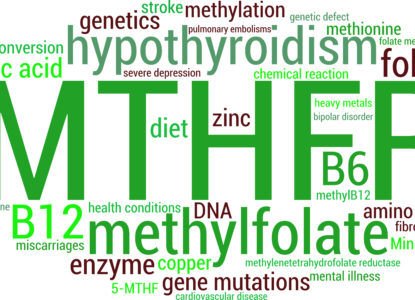Hops Supplements and the Science of Sleep
Article at a Glance
- Hops are approved as a sleep aid by the German government
- There is some evidence that the active ingredient in hops may actually outcompete caffeine for adenosine receptor binding so it may even be effective at sending you to sleep if you regularly consume lots of caffeine.
Genes Mentioned

Contents
Hops are the flowers of the hop plant Humulus lupulus, a cousin of Cannabis. In fact, both plants are a part of the Cannabaceae family of flowering plants. Cannabaceae are distinct in pollinating using the wind, and have male and female sexed plants. 1
Both cannabis and hops also cause a sedative effect. With a bitter flavor, rich in resins, and essential oils, hops are mainly used to flavor and stabilize beer (due to their anti-microbial effect). However, the essential oils derived from hops have also long been used in herbal remedies for the treatment of anxiety and insomnia.
Workers harvesting hops flowers would fall asleep due to coming into close contact with the essential oils, and thus a natural sleep aid was discovered. Hops are approved as a sleep aid by the German government. 2
The legend of the hop harvester led to its widespread use in herbal remedies, and with the advent of molecular analysis, the active ingredient was soon identified as being 2-methyl-3-buten-2-ol (referred to hereafter as “MB”). Note: from here on out, the active ingredient in hops will be referred to as MB. Once in the body, MB is thought to interact with several key pathways involved in promoting deep sleep.
Why hops promote deep sleep
So, as our regular readers know all too well, we are biochemistry nerds here at Gene Food. As such, I am going to dive into some of the mechanisms that drive the relaxation effect we feel when we use hops.
Hops open adenosine receptors
Adenosine is typically derived from the breakdown of adenosine triphosphate (“ATP”), the so called “energy currency” of the body. ATP is formed in the mitochondria of cells using energy derived from carbohydrates or lipids from our food. Once formed ATP can be trafficked, stored or used immediately in a huge variety of cellular processes.
As you can imagine the brain consumes large amounts of ATP when awake, producing large amounts of adenosine, and depleting the brains’ energy stores. As levels mount, adenosine binds to its receptor molecules (ADORA1 and ADORA2) present on neuronal cells which promotes the onset of sleep. When present in high levels we begin to feel sleepy, so high levels of adenosine are known to promote the onset of sleep. 3
By contrast, caffeine blocks the adenosine receptors making it more difficult to sleep.
Hops mimics the action of adenosine
In contrast to caffeine, MB from hops interacts with both ADORA1 and ADORA2A, mimicking the action of adenosine, leading to the induction and maintenance of sleep.
Hops may outcompete caffeine for the adenosine receptor
Indeed, there is some suggestion that MB may actually outcompete caffeine for receptor binding so may even be effective at sending you to sleep if you regularly consume lots of caffeine. 4
Evaluating your adenosine “sleep genes”
While there are many proteins involved in the bodies’ response to the MB from hops, we’re particularly interested in how your genetics influence this. Note: if you want to play along at home, we report on all of these sleep genes in our custom nutrition plans.
As such, there are two genes which we think you’ll be particularly interested in; ADORA2A and the adenosine deaminase gene ADA.
ADORA2A – how does caffeine affect you?
| Protein | Gene | SNP Id | Major Allele/Minor Allele (Risk) | Effect |
| ADORA2A | ADORA2A | rs5751876 | C/T | No change in protein structure. CC allele has problems sleeping with caffeine intake, potential caffeine induced insomnia. (R) (R) TT increased anxiety and panic following caffeine (R) |
Have you ever had a few cups of coffee to stay awake and study, or perhaps on a long road trip? Most of us have. Caffeine is effective at keeping us awake, because, for most of us, it blocks adenosine binding to its receptors, which, as we’ve discussed above, kicks in when our body has burned its energy for that day.
Caffeine binds to the body’s adenosine receptor, preventing your body from using adenosine while you have a coffee buzz. It probably doesn’t come as a surprise that most all adenosine genotypes are impacted by caffeine. In both variants of the adenosine genes, studies show either an inability to sleep after caffeine (most common allele), or increased anxiety and panic after consuming caffeine.
Those with the CC genotype (most common) may be able to fall asleep after consuming caffeine but will likely to have poorer quality sleep. See also: Caffeine consumption: what you need to know.
However, the rarer TT allele is associated with increased anxiety/panic, which would suggest that the pathways activated by the receptor are being inhibited more strongly by caffeine. Still, since there doesn’t seem to be an issue with sleep, the binding time may be shorter. Another possibility is that less ADORA2A is produced in those with the ‘T’ allele, and so caffeine hits the receptors that are present that much harder.
ADA genes – measuring adenosine metabolism and how it impacts sleep quality
| Protein | Gene | SNP Id | Major Allele/Minor Allele (Risk) | Effect |
| ADA | ADA | rs73598374 | G/A | G (Asp) > A (Asn) A associated with 35% reduction in ADA activity. Adenosine is not converted as efficiently and so not cleared by morning. (R) Leads to feeling of sleepiness, impaired attention, and vigor. (R) However, quality of deep sleep improved. (R) |
ADA genes are responsible for an enzyme that converts adenosine into inosine. As the chart above demonstrates, in the world of ADA genes, G is the major (more common) allele, with A the minor (more rare) “risk” allele. Studies show that MB from hops may benefit the G allele more than the A variant. This is the case because the A allele has a tougher time “clearing” adenosine out of the body, leading to grogginess. Those carrying the A allele may have an easier time falling asleep, and achieving good sleep quality, but there will be a feeling of sleepiness, impaired attention, and lack of vigor the following morning.
Hops may benefit ADA G allele more than A allele
MB from hops may benefit those carrying the G allele rather than the A. Those carrying the A allele may benefit from supplements containing zinc or inosine (the breakdown product of adenosine which is thought to also stimulate wakefulness). 5
Hops target GABA receptors
Another major pathway that MB has been shown to interact with is the γ-aminobutyric acid (GABA) pathway. The important role of GABA in modulating sleep is well known, with many hypnotic drugs, often used in surgeries, such as barbiturates which target GABA receptors. 6 GABA molecules are derived from glutamate and synthesized directly in the brain (direct GABA supplementation is controversial, as some studies show it cannot pass into the brain, while others are more favorable). In a similar fashion to adenosine, and its receptors, GABA molecules bind to GABA receptors on neuronal cells in the brain. This binding acts to inhibit neuronal processing creating a sedative effect which favors sleep. GABA has been shown to be particularly important in maintaining deep sleep. It probably doesn’t come as a surprise that GABA levels are reduced in those who suffer from insomnia. There are numerous genes associated with GABA activity, with some correlated with disorders including autism, epilepsy and schizophrenia. 7
Hops are thought to improve GABA biding efficiency
Rather than directly acting on the GABA receptors, MB is instead thought to bind with receptors, and via an unknown mechanism, to improve GABA binding efficiency. (R) However, surprisingly given the important role of GABA in controlling sleep, there are a distinct lack of SNPs with a strong association with difficulty sleeping. This may occur because the pathway is so important in controlling sleep that many mutations have a very harmful effect, meaning they are rarely spread amongst the population.
The GAD1 gene, GABA, and depression
| Protein | Gene | SNP Id | Major Allele/Minor Allele (Risk) | Effect |
| GAD1 | GAD1 | rs769407 | G/C | C associated with depression, early morning awakenings and associated fatigue. No mention of function. (R) |
| GAD1 | GAD1 | rs12185692 | C/A | A associated with depression and fatigue. No mention of function. (R) |
Glutamate decarboxylase 1 (GAD1), is expressed only in the brain, and is responsible for catalyzing the reaction converting glutamate to GABA. Bottom line GAD1 helps your body make GABA. Those carrying the C allele at rs769407, or A allele at rs12185692 in the GAD1 gene were shown to be more at risk of depression, which was the major aim of the study. However, there was also a significant association with early morning awakening and associated fatigue. Whilst the authors don’t describe a method for this activity, we can hypothesize that the enzyme is less active in those with the C allele, resulting in a reduction in GABA production. As GABA is required for good quality deep sleep, it is possible to see a link between its lack and the early morning wakefulness/fatigue in those carrying the C allele. For those carrying the risk alleles for GAD1, MB from hops could be a mechanism for targeting GABA binding efficiency, and perhaps, better sleep as a result.
GRIA3 – A allele hypersensitive to glutamate
| Protein | Gene | SNP Id | Major Allele/Minor Allele (Risk) | Effect |
| GRIA3 | GRIA3 | rs3848874 | G/A | A associated with depression, early morning awakenings and associated fatigue. No mention of function. (R) |
In contrast to GAD1, Glutamate receptor 3 (GRIA3) responds to glutamate signaling to induce wakefulness. Carriers of the A allele of the SNP rs3848874, in the GRIA3 gene, exhibit depression, early morning awakenings and associated fatigue. No mechanism of action is described but we can hypothesize that the A allele leads to increased receptor sensitivity, meaning that even small levels of glutamate can induce an effect, leading to wakefulness and poor quality sleep which would lead to associated fatigue. Carriers of the A allele are hypersensitive to the body’s “wake up” signaling. Impact of hops: In both instances we can hypothesize that MB improves GABA binding to its receptor, which induces a stronger effect, bypassing the negative effects of the risk allele SNPs rs769407 (C), rs12185692 (A) in the GAD1 gene, and rs3848874 (A) in the GRIA3 gene.
Hops bind to melatonin receptors
Melatonin is a hormone produced by the pineal gland located in the brain which is important in regulating sleep pattern (R). Melatonin is produced when the body detects a dark environment (receptors in the eyes are especially important for this) and then interacts with melatonin receptors (MT1 and MT2). MT1 is thought to be responsible for reprogramming of the circadian rhythm (sleep pattern) whereas MT2 is thought to slow cell metabolism promoting sleep. Our modern lifestyles of staying up late in well lit rooms and staring at bright computer, TV and phone screens into the small hours is thought to supress melatonin release, with blue light thought to be especially harmful. It is because of this that it is recommended to avoid using brightly lit screens, or to at least use filters that reduce the amount of blue light reaching the eyes at least an hour before trying to sleep (R). Whilst not specifically looking at MB, general extract of hops was shown to bind to both MT1 and MT2 receptors although with a strong preference for MT2, identifying its mechanism of action. (R)
MTNR1B – melatonin receptor genes and insomnia
| Protein | Gene | SNP Id | Major Allele/Minor Allele (Risk) | Effect |
| MT2 | MTNR1B | rs10830964 | C/T | The T allele was associated with insomnia in a genome wide association study. No mechanism described. (R) |
No mechanism of action was described with the allele. It is also located outside of, but associated with, the MTNR1B gene so it is not possible to hypothesize at this current point. Further work is required to describe a mechanism.
The Bottom Line
A review of the science shows us why workers who harvested hops fell asleep at their jobs. The active ingredient in hops, 2-methyl-3-buten-2-ol, activates our adenosine, GABA, and melatonin receptors, thereby inducing sleep. A review of your genetics can reveal how best to use this natural sleep aid.
MB from hops provides increased activation of ADORA2A and induction of sleep. MB may actually out compete caffeine for access to the adenosine receptor, allowing your body to get a good night’s sleep.




Thank you for this article!
I have gene variant rs73598374 in ADA gene. Where can I find hops in usa and what is it called as a supplement?
Pearl, thanks for the comment. We are launching an herbal sleep product that contains a combination of products that target ADA, that should be live in a couple weeks at the latest. We will notify you when it’s ready.
Pearl, our Sleep Tonight product contains 100mg of hops. It is now live in our store: https://www.mygenefood.com/products/sleep-tonight/
You can also buy hops products on Amazon and many other online retailers. Good luck.
Very interesting